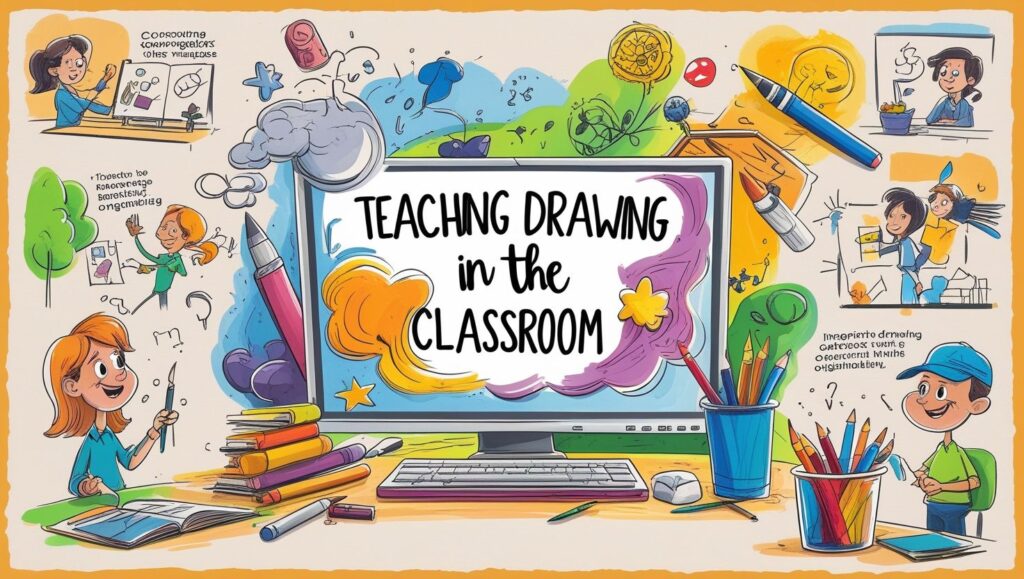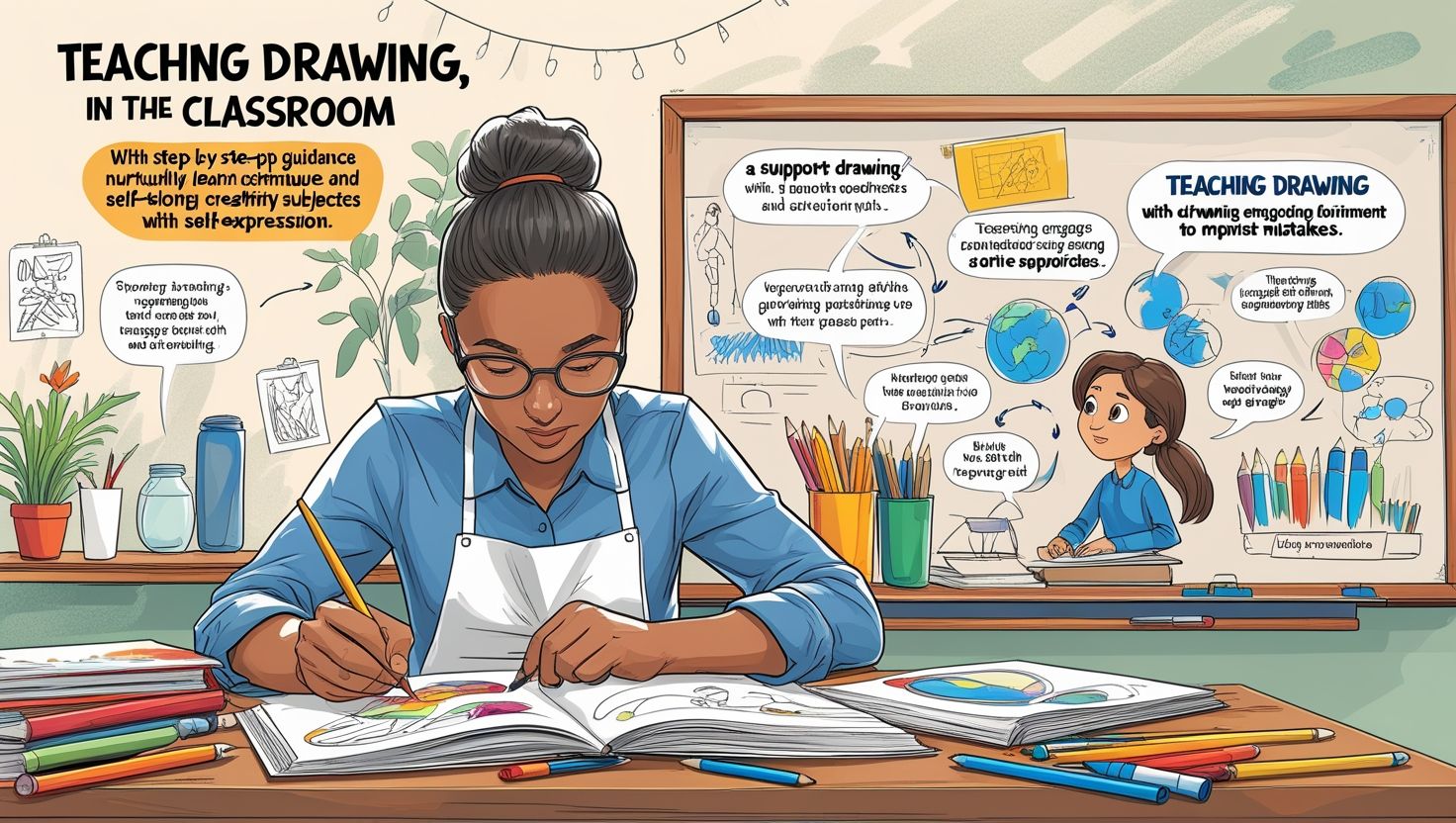Introduction
How to Teach Drawing in Classroom, Teaching drawing in the classroom is not just about art; it is about creativity, expression, and confidence. Drawing gives children the ability to translate their imagination into visuals. In classrooms, it plays an important role in learning and personality development. It encourages problem-solving, observation, and focus. Teachers must create an environment where students feel free to experiment. In fact, drawing can also help in learning other subjects such as science, geography, and history, as it connects visuals with concepts.
Moreover, teaching drawing in classrooms enhances communication skills because students often explain their work. Teachers need structured approaches, patience, and encouragement. By using step-by-step techniques, even those who believe they cannot draw can gradually develop skills. Additionally, integrating drawing with stories and real-life objects makes learning exciting. Thus, teaching drawing in classrooms is a holistic approach that not only nurtures artistic skills but also shapes critical thinking, emotional expression, and overall creativity.
Importance of Drawing in Education
Drawing holds a significant place in education. It fosters imagination, strengthens observation, and refines motor skills. When students draw, they focus more deeply on details, leading to improved concentration. Drawing also supports memory retention because students remember more when they visualize concepts. For example, sketching a plant structure helps them recall biology content more effectively. Moreover, drawing teaches patience and persistence, as completing an artwork requires time and attention. It also provides stress relief, making classrooms more peaceful. Beyond personal benefits, drawing encourages collaboration, as students often share materials, ideas, and feedback.
This builds social interaction skills. Teachers should understand that drawing is not limited to artistic talent but is a universal learning tool. Integrating drawing across different subjects connects knowledge in creative ways. Therefore, it enriches learning experiences and supports multiple intelligences. In this way, drawing becomes a vital educational strategy that not only entertains but also builds life-long learning skills.

Creating a Conducive Environment
To teach drawing effectively, the classroom environment must be supportive and motivating. Students need to feel safe to express themselves without fear of criticism. A positive environment fosters creativity. Teachers should arrange seating that allows free movement and collaboration. Providing proper light and materials is also crucial. Furthermore, setting classroom norms that encourage respect for each other’s work builds confidence. Teachers should display artworks on classroom walls, which creates pride and inspiration.
Additionally, the use of calm background music can enhance focus while drawing. Time management is another essential factor. Allowing specific periods for drawing reduces pressure and encourages relaxation. Teachers should also adapt activities to suit different learning levels so no student feels left out. With these strategies, the environment becomes inviting and inclusive. As a result, students feel encouraged to explore their abilities. Clearly, an enabling classroom setting is the foundation of teaching drawing successfully.
Basic Techniques of Teaching Drawing
Every student must first learn the basics before progressing to complex drawings. Teaching simple techniques builds confidence. Teachers should begin with lines, shapes, and patterns. Gradually, they can introduce shading, proportion, and perspective. Demonstration plays a crucial role because students learn best when they see the process step by step. Teachers may use the board or projector to guide the class. Encouraging practice of basic strokes helps students develop control over their hand movements.
Additionally, exercises like drawing everyday objects build observational skills. To reinforce learning, teachers can integrate simple drawing games, such as completing half-drawn images. Moreover, introducing color theory helps children understand combinations and contrasts. Teachers should also give constructive feedback, pointing out strengths and suggesting improvements. With consistent practice, students move from simple forms to detailed artworks. Thus, teaching drawing basics creates a strong foundation and opens doors to creativity, confidence, and mastery.
Using Step-by-Step Instructions
One of the most effective ways to teach drawing is through step-by-step instruction. Students often feel overwhelmed when asked to create a full drawing at once. Therefore, breaking tasks into smaller steps reduces stress and builds confidence. Clear instructions guide students gradually. For example, a teacher can start with a circle, then add lines to shape a face, and finally include details like eyes and hair. This approach allows students to follow comfortably at their own pace. Visual demonstrations should accompany verbal directions, ensuring better understanding.
Teachers may also use digital tools, such as drawing tutorials or animations, for added clarity. Step-by-step teaching encourages students to focus on process rather than perfection. It highlights progress and skill-building over final results. Consequently, students feel more accomplished. By using structured methods, teachers ensure that all learners, regardless of skill level, can successfully complete their drawings and gain confidence.
Encouraging Creativity and Expression
Teaching drawing is not only about technique; it is also about personal expression. Students should be encouraged to develop their own styles. Creativity brings uniqueness to art. Teachers should avoid imposing rigid rules that suppress individuality. Instead, they can provide themes and allow students freedom to interpret them. For instance, a theme like “my dream home” can result in diverse artistic expressions. Encouraging storytelling through drawings also enhances imagination.
Additionally, teachers can conduct brainstorming sessions before drawing, allowing students to share ideas. Respect for originality must be emphasized, as no two artworks should look identical. Moreover, integrating drawing with students’ emotions helps them express feelings they may not verbalize easily. Encouragement and praise play a vital role in motivating students to experiment with new ideas. Clearly, creativity in drawing is not about perfect images but about honest expression and innovative thinking that enrich classroom learning.
Integrating Drawing with Other Subjects
Drawing should not be restricted to art classes; it can be integrated across subjects. For example, in science, students can sketch diagrams of plants, animals, or human organs. In history, they can draw historical scenes or artifacts. In geography, maps and landscapes can be represented through sketches. Drawing supports interdisciplinary learning. Teachers can use drawing as a memory aid for difficult concepts. Visuals make abstract ideas more concrete and easier to understand. For younger children, drawing letters and numbers helps reinforce literacy and numeracy. Teachers should also use collaborative projects, like drawing charts or group posters, to promote teamwork. Moreover, integrating drawing with storytelling develops both linguistic and artistic abilities. This approach appeals to diverse learners, especially visual learners, who understand better through images. Therefore, drawing across subjects makes learning holistic, engaging, and effective, while also breaking the monotony of traditional teaching methods.

Assessment and Feedback in Drawing
Assessment in drawing is different from other subjects because creativity cannot be measured with strict criteria. Instead, teachers should focus on effort, improvement, and originality. Constructive feedback encourages growth. Teachers should highlight strengths before suggesting improvements. For instance, praising good use of colors before correcting proportions boosts confidence. Peer feedback can also be effective, as students learn by observing and commenting respectfully. Rubrics can be designed based on clarity, creativity, and completion, rather than perfection. Additionally, self-assessment can be introduced, where students reflect on their own progress. Displaying artworks in exhibitions or classroom corners provides recognition and builds pride. Teachers should avoid harsh criticism, which discourages creativity. Instead, feedback should motivate students to keep improving. By focusing on the process rather than just the product, teachers create a supportive learning journey. Clearly, thoughtful assessment ensures that drawing becomes a positive and confidence-building experience for every learner.
Challenges in Teaching Drawing
Teaching drawing in classrooms comes with challenges. Limited resources, time constraints, and diverse skill levels often make it difficult for teachers. Some students may feel discouraged if they cannot draw perfectly. Overcoming these barriers requires patience and strategy. Teachers should provide affordable materials, like pencils and paper, instead of relying on expensive supplies. Time can be managed by dedicating short, regular sessions instead of long ones. Differentiated instruction is important, as not all students progress at the same pace. Teachers must also address the misconception that only “talented” students can draw. Encouraging effort over talent helps build inclusivity.
Classroom discipline may also be a challenge during drawing sessions, as excitement can lead to distraction. Clear rules and structured activities reduce such issues. Moreover, teachers must balance guidance with freedom to maintain creativity. Despite challenges, with flexible approaches, teaching drawing can remain a rewarding and impactful educational practice.
Conclusion
Teaching drawing in classrooms is an enriching process that goes beyond art. It develops creativity, patience, communication, and problem-solving. Students learn to observe, imagine, and express themselves visually. Drawing is not just about skills but about self-expression and learning. Teachers play a vital role by creating supportive environments, introducing step-by-step methods, and integrating drawing into other subjects. By encouraging creativity and respecting individuality, they nurture students’ confidence. Constructive feedback ensures continuous improvement, while fair assessment motivates learners. Although challenges exist, practical solutions can overcome them.
Ultimately, drawing in classrooms contributes to holistic education, balancing intellectual, emotional, and social growth. It prepares students not only to appreciate art but also to apply creativity in every aspect of life. Therefore, teaching drawing in classrooms is essential for nurturing innovative thinkers and expressive individuals who will thrive in their educational journeys and beyond.
References
- Eisner, E. W. (2002). The Arts and the Creation of Mind. Yale University Press.
- Winner, E., Goldstein, T. R., & Vincent-Lancrin, S. (2013). Art for Art’s Sake? The Impact of Arts Education. OECD Publishing.
- Edwards, B. (2012). Drawing on the Right Side of the Brain. Penguin.
- Lowenfeld, V., & Brittain, W. L. (1987). Creative and Mental Growth. Macmillan.
- Hetland, L., Winner, E., Veenema, S., & Sheridan, K. (2013). Studio Thinking 2: The Real Benefits of Visual Arts Education. Teachers College Press.

This helped clarify a lot of questions I had.